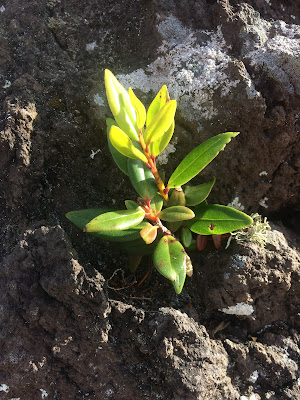This is a blog article I wanted to do simply because I loved the different plants on the island that you don't get to see at home. I'd like to know more about them. Someday I'm going to have to pick up a plant book and pack it around with me so I can identify them. Here's some of my favorite from the island.
I mentioned these first two in a previous blog but thought I should include them again with the other vegetation. This was a unique tree to me because I couldn't figure out if it was like a palm tree but had different bark and different leaves.
This trees leaves looked and felt like they were rubber.
This bush was right outside our hotel. I wish I had gotten a closer up picture of the blossoms. It was so pretty. I think we have a similar one at home - even in our front yard but I couldn't tell you what it is.
This little tree was also just outside our hotel (obviously). The used these as parking spot markers. I don't know if this is how tall they grow or if they're just babies.
Another rubberish looking plant. Everything is so healthy and green here.
This plant reminded me of geraniums but perhaps a wild variety?
This tree has fascinated me. I first saw it in New Zealand. To me it looks fake. You see them all over though so I know it's not. They must only grow in tropical climates though...or at least that's the only places I've seen them. The next couple of pictures are close-ups of the needles. It's so strange how they grow in these cylinder type bundles.
This tree reminded me of a fern on a stick. So delicate.
Another pretty flower from the island. Looks similar to ones we have at home. Here they grow wild though.
Wild petunia perhaps? That's what this plant reminds me of. Maybe morning glory? Again this grows wild and you see it all over. So pretty.
This isn't a great picture but I wanted to include it. This lone flower was growing all by itself in a trail that we hiked down. It was so delicate. I'm glad someone hadn't stepped on it.
The leaves on this bush were huge. How do you know where the base is to water this? Maybe they don't have to do that here since they don't live in a desert like I do.
This little plant was growing out of the rocky sharp edges of the lava rocks. How does it do that?
These are ALL OVER the island. They had peaked when we arrived so many of them had started to wilt and turn brown. We did see a lot still in their vibrant colors - yellow, white, pink, blue and purple. I think these are called hydrangeas. We grow them at home but not like here. There were so many I wondered if they were a national flower or something.
This struck me as looking almost deserty. Just a cool plant at a park on the edge of the ocean.
More plants growing in adverse conditions and surviving. This one was on one of the really tall rock walls. Somehow it had gotten a hold and had grown to be about 6 feet in length.
Another plant growing out of the lava rock. I understand that lava rock makes good soil once it breaks down so I suppose this is how these plant make it.
I believe this is the invasive species that was introduced from South Africa that now they are trying to eradicate. It does well here but apparently they don't like it.
I loved the delicate blossoms of this tree.
More wild bushes - such pretty colors.
I'm not sure what the fascination is with cactus but we saw these types of planters every now and then. At the hotel dining room they have small cactuses on each of the tables. A complete opposite of the area they are living in. Interesting...
This tree was right out side or balcony. I love the red flowers it produces.
We saw this flower all over the island. Its a bit strange in that it grows on this skinny little stick with this huge blossom. They've got to be some sort of lily.
So many beautiful plants. Next time I'll come prepared with a book to identify them.






























No comments:
Post a Comment